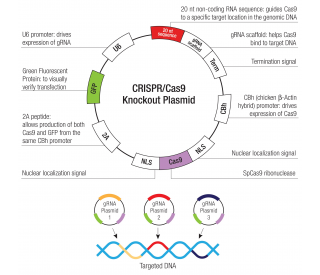Species Reactivity
Human
Specificity
Detects human GDF-11/BMP-11 in direct ELISAs. In direct ELISAs, no cross-reactivity with recombinant human BMP-6 or recombinant mouse GDF-8 is observed.
Source
Monoclonal Mouse IgG 1 Clone # 743833
Purification
Protein A or G purified from hybridoma culture supernatant
Immunogen
E. coli-derived recombinant human GDF-11/BMP-11
Asn299-Ser407
Accession # O95390Formulation
Lyophilized from a 0.2 μm filtered solution in PBS with Trehalose. *Small pack size (SP) is supplied as a 0.2 µm filtered solution in PBS.
Label
Unconjugated
Applications
Recommended
ConcentrationSample
Immunohistochemistry
8-25 µg/mL
See below
Please Note: Optimal dilutions should be determined by each laboratory for each application. are available in the Technical Information section on our website.
Data Examples
Immunohistochemistry | GDF‑11/BMP‑11 in Human Colon Cancer Tissue. GDF‑11/BMP‑11 was detected in immersion fixed paraffin-embedded sections of human colon cancer tissue using Mouse Anti-Human GDF‑11/BMP‑11 Monoclonal Antibody (Catalog # MAB19581) at 15 µg/mL overnight at 4 °C. Tissue was stained using the Anti-Mouse HRP-DAB Cell & Tissue Staining Kit (brown; Catalog # ) and counterstained with hematoxylin (blue). Lower panel shows a lack of labeling when primary antibodies are omitted and tissue is stained only with secondary antibody followed by incubation with detection reagents. Specific staining was localized to epithelia of the colon. View our protocol for . |
Preparation and Storage
Reconstitution
Sterile PBS to a final concentration of 0.5 mg/mL.
Shipping
The product is shipped at ambient temperature. Upon receipt, store it immediately at the temperature recommended below. *Small pack size (SP) is shipped with polar packs. Upon receipt, store it immediately at -20 to -70 °C
Stability & Storage
Use a manual defrost freezer and avoid repeated freeze-thaw cycles.
12 months from date of receipt, -20 to -70 °C as supplied.
1 month, 2 to 8 °C under sterile conditions after reconstitution.
6 months, -20 to -70 °C under sterile conditions after reconstitution.
Background: GDF-11/BMP-11
Growth Differentiation Factor 11 (GDF-11), also known as BMP-11, is a member of the TGF-beta superfamily and is highly related to GDF-8. GDF-11 encodes a 407 amino acid (aa) prepropeptide which contains a signal sequence for secretion and an RXXR proteolytic processing site to yield a 109 aa residue carboxy-terminal mature protein (1). Mature GDF-11 contains the canonical 7-cysteine motif common to other TGF-beta superfamily members; however, like the TGF-beta s, Activins and GDF-8, GDF-11 also contains one extra pair of cysteine residues. At the amino acid sequence level, mature human, mouse, rat and chicken GDF-11 are 99‑100% identical. GDF-11 and GDF-8 share 90% amino acid sequence identity within the mature protein. As detected by in situ hybridization, GDF-11 is expressed in diverse regions of the mouse embryo: tailbud, somitic precursors, limbs, mandibular and branchial arches, dorsal neural tube, odontoblasts, nasal epithelium, and particular regions of the brain (1, 2). Likewise, a targeted deletion of GDF-11 in mice results in a spectrum of abnormalities including palatal malformation, vertebral defects, elongated trunks with a reduced or absent tail, missing or malformed kidneys, and an increased number of neurons in the olfactory epithelium (2-5). An intriguing finding in the knockout mice was that the trunk elongation was due to an increase in the number of thoracic vertebrae (4). This implicates GDF-11 as the first secreted factor to influence the specification of segmental identity in vertebrates (3). In fact, GDF-11 does regulate expression of segmental transcription factors, the Hox genes (6). GDF-11 signals through the Activin type II receptors and induces phosphorylation of Smad2 to mediate axial patterning (7). Despite the strong expression in the limb throughout development, no limb abnormalities were found in the knockout mice. However, in vitro micromass studies indicate that GDF-11 inhibits myogenic and chondrogenic cell differentiation and may impact formation and development of the limb skeleton (6).
References:
Gamer, L.W. et al. (1999) Dev. Biol. 208: 222.
Nakashima, M. et al. (1999) Mech. Dev. 80:185.
Gad, J.M. and P.P.L. Tam (1999) Curr. Biol. 9:R783.
McPherron, A.C. et al. (1999) Nat. Genet. 22:260.
Esquela, A.F. and S.J. Lee (2003) Dev. Biol. 257:356.
Gamer, L.W. et al. (2001) Dev. Biol. 229:407.
Oh, S.P. et al. (2002) Genes & Dev. 16:274.
Long Name:
Growth Differentiation Factor 11
Entrez Gene IDs:
10220 (Human)
Alternate Names:
BMP-11; BMP-11BMP11Bone morphogenetic protein 11; GDF11; GDF-11; growth differentiation factor 11; growth/differentiation factor 11










